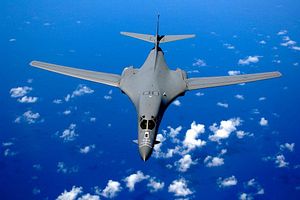The United States Air Force (USAF) will conduct a bomber flight over South Korea on September 13 to show off its defense commitment to Seoul following North Korea’s fifth-ever nuclear test, Yonhap news agency reports.
According to United States Forces Korea (USFK), the flight over Osan Air Base of two supersonic B-1B Lancer heavy strategic bombers, escorted by USAF F-16 fighter jets and ROK Air Force F-15K warplanes, was originally scheduled for September 12, but had to be canceled due to unfavorable weather conditions.
“Due to inclement weather conditions, the engagement at Osan Air Base scheduled for today has been postponed,” a USFK spokesperson told Yonhap on September 12. The B-1Bs were slated to take off from Andersen Air Force Base on Guam in the western Pacific, where the USAF has recently deployed an undisclosed number of B-1Bs, replacing the base’s fleet of B-52H long-range heavy bombers (See: “US Air Force Deploys Supersonic Strategic Bombers to the Pacific”).
In what can be considered the United States’ stock response to Pyongyang’s saber rattling, the USAF dispatched a B-52H, accompanied on its flight by two ROK F-15Ks and two USAF F-16s, to the Korean peninsula in January to conduct a deterrence patrol in response to a recent North Korean nuclear test. (The Diplomat’s Van Jackson wrote a short piece critiquing U.S. bomber overflights and the failure of U.S. nuclear signaling vis-a-vis North Korea.)
Furthermore, the USAF has also recently sent three B-2 Spirit nuclear-capable stealth bombers to Guam to participate in a number of training exercises with U.S. allies in the Asia-Pacific region. In the past, B-2s have also participated in deterrence patrols over the Korean peninsula, as I noted elsewhere:
The last time the USAF deployed B-2s to Guam was in March 2016, amidst tensions on the Korean peninsula. The United States also dispatched B-2s to the Asia-Pacific region in 2015 and 2013 in a show of force to deter North Korean aggression. B-2s also entered North Korean airspace in 2013.
However, this will be the first time in recent history that B1-Bs will fly over South Korea as a sign of resolve and solidarity with Seoul. (Indeed, it is the first time in over a decade that the USAF has sent its heaviest supersonic strategic bomber to the Asia-Pacific region.) The B-1B is a formidable fighting machine as I summarized last month:
The USAF’s 62 B-1B Lancers are capable of carrying up to 75,000 pounds (34,000 kilograms) of weapons—the largest payload of both guided and unguided weapons in the USAF’s inventory. Though heavily armed, the bomber can reach a top speed of Mach 1.2 and can operate at altitudes above 30,000 feet (9,100 meters). The B-1B bombers will be permanently stationed on Guam as part of U.S. Pacific Command’s so-called Continuous Bomber Presence.
A number of South Korean defense analysts have called for the permanent stationing of heavy U.S. strategic bombers on the Korean peninsula to deter further aggression from Pyongyang in lieu of Seoul acquiring its own strategic nuclear arsenal. “Guam is now under the influence of a typhoon. But it doesn’t make sense for a U.S. strategic bomber to not take off due to cross winds. If the U.S. locates its bombers in South Korea, it will help deter threats from the North,” said one analyst.

































